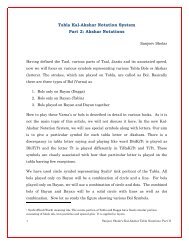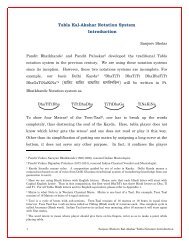Tabla Kal-Akshar Notation System Part 1: Kal, Taal ... - Tabla Notations
Tabla Kal-Akshar Notation System Part 1: Kal, Taal ... - Tabla Notations
Tabla Kal-Akshar Notation System Part 1: Kal, Taal ... - Tabla Notations
You also want an ePaper? Increase the reach of your titles
YUMPU automatically turns print PDFs into web optimized ePapers that Google loves.
After giving information on basic <strong>Taal</strong> configuration let us see how we can define<br />
Jaati and its associated speed in the given composition.<br />
There are many compositions (Kayda, Tukada, Chakradhar, etc.) where within<br />
the full note there are sub-parts like half note, quarter note or in <strong>Tabla</strong> lingo<br />
Laghu. There can be any number of laghus in a Matra [or a full note can be<br />
divided in any number of division from 2 (half note or minim) to 16 (semiquaver<br />
or 16 th ) or even more]. Compositions having up to 8 laghus (quaver or eighth<br />
note) in one full note are very common; division up to 12 laghu (12 th part) in one<br />
full note is also seen in some composition. Division of full note to more than 12<br />
laghu (more than 12 th part, like 16 th , semiquaver), though theoretically possible,<br />
is very rare statistically.<br />
In <strong>Tabla</strong> time measurement, we also have to pay attention ‘Jaati’. Jaati<br />
represents the basic division of laghus in a full note. Various types of Jaati like<br />
Tisra (three laghus), Chatasra (four laghus), Khanda (five laghus), Mishra (seven<br />
laghus) or Sankirna (nine laghus) are known. There is always a confusion<br />
regarding the Jaati of a <strong>Taal</strong> or Jaati of a composition (bandish). The basic Teen<br />
<strong>Taal</strong> is considered as Chatasra Jaati <strong>Taal</strong> since its total 16 Matras (16 full notes)<br />
are divisible by 4. Likewise Ek<strong>Taal</strong> is Tisra Jaati <strong>Taal</strong> (12 Matras are divisible by<br />
3), Zap<strong>Taal</strong> is Khanda Jaati <strong>Taal</strong> (10 Matras are divisible by 5); Roopak <strong>Taal</strong> is<br />
Mishra Jaati <strong>Taal</strong> (divisible by 7), etc. However this is a complete misconception<br />
regarding <strong>Taal</strong> having Jaati. There are NO Jaati for a <strong>Taal</strong>. Jaati is for<br />
composition and not for a <strong>Taal</strong>. If a articular composition has 3 laghus in one<br />
Matra (full note) consistently, then that composition is considered as Tisra Jaati<br />
composition. For example, we take a Tisra Jaati Kayda in Teen <strong>Taal</strong>.<br />
DhaGeNa DhaTraKa DhiKiTt DhaGeNa<br />
DhaTraKa DhiNa@ DhiNaDhi NaGiNa<br />
3 Sanjeev Shelar's <strong>Kal</strong>-<strong>Akshar</strong> <strong>Tabla</strong> <strong>Notation</strong>: <strong>Part</strong> I




 Ym{VQ> YmYm{VQ - Tabla Notations"
>
Ym{VQ> YmYm{VQ - Tabla Notations"
>